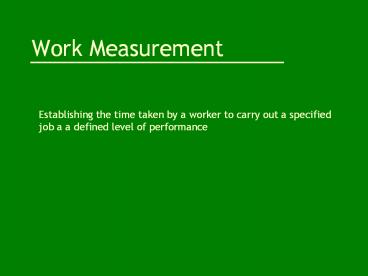Work Measurement PowerPoint PPT Presentation
1 / 62
Title: Work Measurement
1
Work Measurement
- Establishing the time taken by a worker to carry
out a specified job a a defined level of
performance
2
Purpose of Work Measurement
- To reduce the amount of ineffective time
- Provides management with a means of identifying
the causes of ineffective time
3
Uses of Work Measurment
- To compare the efficiency of alternative work
methods - To balance the work of members of teams
- To determine the number of machines an operative
can run
4
Work Standards
- A work standard is the time required for a
trained worker to perform a task with normal
effort and skills
5
Uses of Work Standards
- Capacity planning
- Scheduling
- Costing
- Performance appraisal
- Motivating workers with incentives
6
Areas of Controversy
- Conflict between management and workers
- Workers think standards too high
- Management think standards too low
- Conflicts expensive
- Need achievable standards for costing, scheduling
etc. - Time studies dehumanising
- Industrial Engineering departments expensive
- Using work standards for piecework incentives
reduces incentive to improve work methods - Trade off with quality
7
Work Measurement Techniques
- Time study
- Activity sampling
- Predetermined motion time systems
- Synthesis from standard data
- Estimating
- Analytical estimating
- Comparative estimating
8
Time Study
- Select work elements
- Timing the elements
- Determine sample time
- Setting the work standard
9
Selecting Work Elements
- Obvious starting and stopping points
- Long enough to accurately time
- Should have been running smoothly for a period of
time in a standard work environment - Separate incidental operations from the
repetetive work
10
Timing Work Elements
- Stopwatch
- Investigate single sample times that differ
greatly from other timings for the same element.
Dont include irregular occurencies, use
allowances.
11
Determining Sample Size
- We are trying to estimate the average of the true
time distribution to a certain precision with a
particular confidence - Do a set of initial samples
- Use
n required sample size p precision of
estimate as a proportion of true value t mean
time from sample (the select time) ? standard
deviation of sample times z number of standard
deviations for desired confidence
12
Packaging Coffee Cups
Time Study Method
13
Packaging Coffee Cups
Step 1 Selecting Work Elements
14
Packaging Coffee Cups
15
Packaging Coffee Cups
16
Packaging Coffee Cups
17
Packaging Coffee Cups
Step 3 Determining the Sample Size
18
Packaging Coffee Cups
Step 3 Determining the Sample Size
19
Packaging Coffee Cups
Desired Confidence () z 90 1.65 95 1.96 96
2.05 97 2.17 98 2.33 99 2.58
Step 3 Determining the Sample Size
n ( )( )
1.96 ? 0.04 t
2
20
Packaging Coffee Cups
21
Packaging Coffee Cups
22
Packaging Coffee Cups
23
Packaging Coffee Cups
24
Packaging Coffee Cups
25
Packaging Coffee Cups
26
Packaging Coffee Cups
27
Packaging Coffee Cups
28
Packaging Coffee Cups
29
Packaging Coffee Cups
30
Packaging Coffee Cups
31
Setting the Work Standard
- Need to judge the pace of the worker to produce a
rating factor (RF). - RF lt 1 means worker going slower than standard
- RF gt 1 means worker going faster than standard
- Allowances
- Contingency Allowance. For legitimate and
expected work or delays which are uneconomic to
measure - Relaxation Allowance. To allow for physiological
or psychological effects of conditions eg. - 5-7 Personal
- 0-10 Energy Output
- 0-5 Noisy
- 0-100 Conditions
32
Setting the Work Standard
- Basic time (BT) in Basic Minutes (BM) is
- Observed Time Rating Factor
- Basic Time for Cycle (BTC) is
- ? BT
- Standard time is
- BTC Allowances
33
Packaging Coffee Cups
34
Packaging Coffee Cups
35
Packaging Coffee Cups
36
Packaging Coffee Cups
Step 4 Setting the Standard
(after 48 additional observations)
Work Element t RF BT 1. Get
carton 0.26 1.05 2. Put liner in
carton 0.10 0.95 3. Place cups in
carton 0.75 1.10 4. Seal carton and set
aside 1.08 0.90
BT 0.26 1.05
37
Packaging Coffee Cups
38
Packaging Coffee Cups
39
Packaging Coffee Cups
40
Packaging Coffee Cups
41
Packaging Coffee Cups
42
Packaging Coffee Cups
43
Packaging Coffee Cups
44
Packaging Coffee Cups
45
Packaging Coffee Cups
46
Packaging Coffee Cups
47
Packaging Coffee Cups
48
Packaging Coffee Cups
49
Packaging Coffee Cups
50
Packaging Coffee Cups
51
Packaging Coffee Cups
52
Activity Sampling
- A large number of instantaneous observations made
over a length of time - Percentage of observations in which an activity
is taking place approximates proportion of total
time that activity takes place
53
Activity Sampling
- Advantages
- Can measure activities which are too impractical
or costly to measure by time study - Only needs one observer
- Sampling can be interrupted
- Disadvantages
- Quicker and easier to use Work Study on jobs of
short duration - Does not provide elemental detail
54
Number of Samples
55
Number of Samples
n required sample size p estimate of
proportion time an activity takes place z
number of standard deviations for desired
confidence e maximum error allowable
56
Predetermined Motion Time System
- Use established timings for basic human movements
to build up time for job - Potentially accurate
- Can be used before production in place
- Performance ratings may not be required
- Time consuming
- Cant use for low repeatability jobs
- Different part shapes
57
Predetermined Motion Time System
58
Predetermined Motion Time System
59
Predetermined Motion Time System
60
Predetermined Motion Time System
61
Synthesis
- Build up job times from previous element times
from studies on other jobs - Useful where new jobs made up of well understood
elements
62
Estimating
- Estimate made by person familiar with job
- Least accurate of all methods

